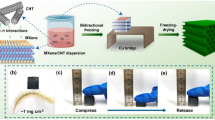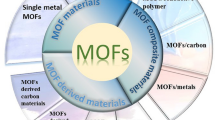Abstract
The conversion of biomass waste into economical and high-performance energy storage devices receives significant attention. Herein, a facile and green method to prepare porous active carbon from walnut septum is applied to the electrode materials of supercapacitors. The effect of chemical etching reagent (KOH) on the microstructure and specific capacitance of the porous carbon are explored. The modified BC-2.0, with a KOH/walnut septum mass ratio of 2:1, exhibits large specific surface area of 1003.9 m2·g−1 with hierarchical micro-mesoporous structures. BC-2.0 reveals a superior specific capacitance of 457 F·g−1 at 1 A·g−1. The flexible symmetric supercapacitor in gel electrolyte (KOH/PVA) exhibits considerable synergetic energy–power output performance. The results indicate that walnut septum is a better precursor to obtain activated carbons relative to other biomass carbon sources. The large mesoporosity after activation effectively boosts the electrochemical properties of supercapacitor. Consequently, the walnut septum has potential to be a superior electrode material for supercapacitors.
Graphical abstract

摘要
将生物质废料转化为经济且高效的储能装置受到了极大的关注。本文利用了一种简便、绿色的方法来制备核桃分心木衍生多孔活性炭, 并首次将其用作超级电容器的电极材料。研究了化学蚀刻试剂(KOH)对多孔碳微观结构和比电容的影响。改良后的BC-2.0, KOH/核桃隔膜质量比为2:1, 具有较高的比表面积(1003.9 m2·g−1) 和层次分明的微孔结构。BC-2.0在1 A·g-1时显示时显示出较高的比电容457 F·g−1。柔性对称电容器在凝胶电解质(KOH/PVA)中表现出了可观的协同能量输出性能。结果表明, 与其他生物质碳源相比, 核桃分心木是一种较好的前驱体。活化后的大介孔率可以有效地提高超级电容器的电化学性能。因此, 核桃分心木有潜力成为超级电容器的优良电极材料。








Similar content being viewed by others
References
Ke CZ, Liu F, Zheng ZM, Zhang HH, Cai MT, Li M, Yan QZ, Chen HX, Zhang QB. Boosting lithium storage performance of Si nanoparticles via thin carbon and nitrogen/phosphorus co-doped two-dimensional carbon sheet dual encapsulation. Rare Met. 2021;40(6):1347.
Yan S, Luo S, Feng J, Li P, Guo R, Wang Q, Zhang Y, Liu Y, Bao S. Rational design of flower-like FeCo2S4/reduced graphene oxide films: novel binder-free electrodes with ultra-high conductivity flexible substrate for high-performance all-solid-state pseudocapacitor. Open Chem Eng J. 2020;381:122695.
Mei P, Kaneti YV, Pramanik M, Takei T, Dag Ö, Sugahara Y, Yamauchi Y. Two-dimensional mesoporous vanadium phosphate nanosheets through liquid crystal templating method toward supercapacitor application. Nano Energy. 2018;52:336.
Lin S, Wang F, Shao Z. Biomass applied in supercapacitor energy storage devices. J Mater Sci. 2020;56(3):1943.
Zheng SQ, Wu ZH, Wang JT, Zhang XJ. Performance of high capacity silicon/carbon anodes with different pore structures. Chin J Rare Met. 2020;44(3):225.
Jiang Y, Li J, Jiang Z, Shi M, Sheng R, Liu Z, Zhang S, Cao Y, Wei T, Fan Z. Large-surface-area activated carbon with high density by electrostatic densification for supercapacitor electrodes. Carbon. 2021;175:281.
Liu Z, Hu J, Shen F, Tian D, Huang M, He J, Zou J, Zhao L, Zeng Y. Trichoderma bridges waste biomass and ultra-high specific surface area carbon to achieve a high-performance supercapacitor. J Power Sources. 2021;497:229880.
Xie P, Yuan W, Liu X, Peng Y, Yin Y, Li Y, Wu Z. Advanced carbon nanomaterials for state-of-the-art flexible supercapacitors. Energy Storage Mater. 2021;36:56.
Young C, Kim J, Kaneti Y, Yamauchi Y. One-step synthetic strategy of hybrid materials from bimetallic metal-organic frameworks for supercapacitor applications. ACS Appl Energy Mater. 2018;1(5):2007.
Rajesh M, Manikandan R, Park S, Kim BC, Cho WJ, Yu KH, Raj CJ. Pinecone biomass-derived activated carbon: the potential electrode material for the development of symmetric and asymmetric supercapacitors. Int J Energy Res. 2020;44(11):8591.
Gu J, Sun L, Zhang Y, Zhang Q, Li X, Si H, Shi Y, Sun C, Gong Y, Zhang Y. MOF-derived Ni-doped CoP@C grown on CNTs for high-performance supercapacitors. Chem Eng J. 2020;385:123454.
Su X, Chen J, Zheng G, Yang J, Guan X, Liu P, Zheng X. Three-dimensional porous activated carbon derived from loofah sponge biomass for supercapacitor applications. Appl Surf Sci. 2018;436:327.
Lian J, Xiong L, Cheng R, Pang D, Tian X, Lei J, He R, Yu X, Duan T, Zhu W. Ultra-high nitrogen content biomass carbon supercapacitors and nitrogen forms analysis. J Alloys Compd. 2019;809:151664.
Jin H, Li J, Yuan Y, Wang J, Lu J, Wang S. Recent progress in biomass-derived electrode materials for high volumetric performance supercapacitors. Adv Energy Mater. 2018;8(23):1801077.
Wang Y, Qu Q, Gao S, Tang G, Liu K, He S, Huang C. Biomass derived carbon as binder-free electrode materials for supercapacitors. Carbon. 2019;155:706.
Huang B, Liu Y, Xie Z. Two dimensional nanocarbons from biomass and biological molecules: synthetic strategies and energy related applications. J Energy Chem. 2021;54:795.
Du J, Zhang Y, Lv H, Chen A. Silicate-assisted activation of biomass towards N-doped porous carbon sheets for supercapacitors. J Alloys Compd. 2021;853:157091.
Liu L, Zhao H, Lei Y. Review on nanoarchitectured current collectors for pseudocapacitors. Small Methods. 2019;3(8):180031.
Choudhary RB, Ansari S, Majumder M. Recent advances on redox active composites of metal-organic framework and conducting polymers as pseudocapacitor electrode material. Renew Sustain Energy Rev. 2021;145:110854.
Peurifoy SR, Russell JC, Sisto TJ, Yang Y, Roy X, Nuckolls C. Designing three-dimensional architectures for high-performance electron accepting pseudocapacitors. J Am Chem Soc. 2018;140(35):10960.
Jiang SH, Ding J, Wang RH, Chen FY, Sun J, Deng YX, Li XL. Solvothermal-induced construction of ultra-tiny Fe2O3 nanoparticles/graphene hydrogels as binder-free high-capacitance anode for supercapacitors. Rare Met. 2021;40(12):3520.
Ma W, Chen S, Yang S, Chen W, Weng W, Cheng Y, Zhu M. Flexible all-solid-state asymmetric supercapacitor based on transition metal oxide nanorods/reduced graphene oxide hybrid fibers with high energy density. Carbon. 2017;113:151.
Zhang G, Xiao X, Li B, Gu P, Xue H, Pang H. Transition metal oxides with one-dimensional/one-dimensional-analogue nanostructures for advanced supercapacitors. J Mater Chem A. 2017;5(18):8155.
Liang X, Liu R, Wu X. Biomass waste derived functionalized hierarchical porous carbon with high gravimetric and volumetric capacitances for supercapacitors. Microporous Mesoporous Mater. 2021;310:110659.
Lin G, Ma R, Zhou Y, Liu Q, Dong X, Wang J. KOH activation of biomass-derived nitrogen-doped carbons for supercapacitor and electrocatalytic oxygen reduction. Electrochim Acta. 2018;261:49.
Wang Y, Ding Y, Guo X, Yu G. Conductive polymers for stretchable supercapacitors. Nano Res. 2019;12(9):1978.
Han X, Xiao G, Wang Y, Chen X, Duan G, Wu Y, Gong X, Wang H. Design and fabrication of conductive polymer hydrogels and their applications in flexible supercapacitors. J Mater Chem A. 2020;8(44):23059.
Pokharel J, Gurung A, Baniya A, He W, Chen K, Pathak R, Lamsal BS, Ghimire N, Zhou Y. MOF-derived hierarchical carbon network as an extremely-high-performance supercapacitor electrode. Electrochim Acta. 2021;394:139058.
Deng T, Lu Y, Zhang W, Sui M, Shi X, Wang D, Zheng W. Inverted design for high-performance supercapacitor via Co(OH)2-derived highly oriented MOF electrodes. Adv Energy Mater. 2018;8(7):1702294.
Wang C, Xiong Y, Wang H, Sun Q. All-round utilization of biomass derived all-solid-state asymmetric carbon-based supercapacitor. J Colloid Interface Sci. 2018;528:349.
Tan Z, Yang J, Liang Y, Zheng M, Hu H, Dong H, Liu Y, Xiao Y. The changing structure by component: biomass-based porous carbon for high-performance supercapacitors. J Colloid Interface Sci. 2021;585:778.
Zhang W, Xu J, Hou D, Yin J, Liu D, He Y, Lin H. Hierarchical porous carbon prepared from biomass through a facile method for supercapacitor applications. J Colloid Interface Sci. 2018;530:338.
Gong Y, Li D, Luo C, Fu Q, Pan C. Highly porous graphitic biomass carbon as advanced electrode materials for supercapacitors. Green Chem. 2017;19(17):4132.
Yu D, Ma Y, Chen M, Dong X. KOH activation of wax gourd-derived carbon materials with high porosity and heteroatom content for aqueous or all-solid-state supercapacitors. J Colloid Interface Sci. 2019;537:569.
Xu M, Huang Q, Sun R, Wang X. Simultaneously obtaining fluorescent carbon dots and porous active carbon for supercapacitors from biomass. RSC Adv. 2016;6(91):88674.
Wen X, Lu X, Xiang K, Xiao L, Liao H, Chen W, Zhou W, Chen H. Nitrogen/sulfur co-doped ordered carbon nanoarrays for superior sulfur hosts in lithium-sulfur batteries. J Colloid Interface Sci. 2019;554:711.
Shi L, Li X, Jia Y, Kong D, He H, Wagner M, Müllen K, Zhi L. Continuous carbon nanofiber bundles with tunable pore structures and functions for weavable fibrous supercapacitors. Energy Stor Mater. 2016;5:43.
Zhu K, Wang Y, Tang JA, Guo S, Gao Z, Wei Y, Chen G, Gao Y. A high-performance supercapacitor based on activated carbon fibers with an optimized pore structure and oxygen-containing functional groups. Mater Chem Front. 2017;1(5):958.
Vijayakumar M, Bharathi Sankar A, Sri Rohita D, Rao TN, Karthik M. Conversion of biomass waste into high performance supercapacitor electrodes for real-time supercapacitor applications. ACS Sustain Chem Eng. 2019;7(20):17175.
Yan S, Wang Q, Luo S, Zhang Y, Liu X, Liu Y, Wang Z, Hao A, Yi T. Coal-based S hybrid self-doped porous carbon for high-performance supercapacitors and potassium-ion batteries. J Power Sources. 2020;461:228151.
Barzegar F, Bello A, Dangbegnon JK, Manyala N, Xia X. Asymmetric supercapacitor based on activated expanded graphite and pinecone tree activated carbon with excellent stability. Appl Energy. 2017;207:417.
Fu F, Yang D, Zhang W, Wang H, Qiu X. Green self-assembly synthesis of porous lignin-derived carbon quasi-nanosheets for high-performance supercapacitors. Open Chem Eng J. 2020;392:123721.
Yadav P, Basu A, Suryawanshi A, Game O, Ogale S. Highly stable laser-scribed flexible planar microsupercapacitor using mushroom derived carbon electrodes. Adv Mater Interfaces. 2016;3(11):1600057.
Lin X, Yang N, Lü Q, Liu R. Self-nitrogen-doped porous biocarbon from watermelon rind: a high-performance supercapacitor electrode and its improved electrochemical performance using redox additive electrolyte. Energy Technol. 2019;7(3):1800628.
Du W, Zhang Z, Du L, Fan X, Shen Z, Ren X, Zhao Y, Wei C, Wei S. Designing synthesis of porous biomass carbon from wheat straw and the functionalizing application in flexible, all-solid-state supercapacitors. J Alloys Compd. 2019;797:1031.
Liu C, Chen W, Hong S, Pan M, Jiang M, Wu Q, Mei C. Fast microwave synthesis of hierarchical porous carbons from waste palm boosted by activated carbons for supercapacitors. Nanomaterials. 2019;9(3):405.
Liu Y, Qu X, Huang G, Xing B, Zhang F, Li B, Zhang C, Cao Y. 3-Dimensional porous carbon with high nitrogen content obtained from longan shell and its excellent performance for aqueous and all-solid-state supercapacitors. Nanomaterials. 2020;10(4):808.
Ai J, Yang S, Sun Y, Liu M, Zhang L, Zhao D, Wang J, Yang C, Wang X, Cao B. Corncob cellulose-derived hierarchical porous carbon for high performance supercapacitors. J Power Sources. 2021;484:229221.
Li F, Wang X, Sun R. A metal-free and flexible supercapacitor based on redox-active lignosulfonate functionalized graphene hydrogels. J Mater Chem A. 2017;5(39):20643.
Yi J, Qing Y, Wu C, Zeng Y, Wu Y, Lu X, Tong Y. Lignocellulose-derived porous phosphorus-doped carbon as advanced electrode for supercapacitors. J Power Sources. 2017;351:130.
Zheng Z, Gao Q. Hierarchical porous carbons prepared by an easy one-step carbonization and activation of phenol–formaldehyde resins with high performance for supercapacitors. J Power Sources. 2011;196(3):1615.
Wang D, Wang Y, Chen Y, Liu W, Wang H, Zhao P, Li Y, Zhang J, Dong Y, Hu S, Yang J. Coal tar pitch derived N-doped porous carbon nanosheets by the in-situ formed g-C3N4 as a template for supercapacitor electrodes. Electrochim Acta. 2018;283:132.
Wei T, Wei X, Yang L, Xiao H, Gao Y, Li H. A one-step moderate-explosion assisted carbonization strategy to sulfur and nitrogen dual-doped porous carbon nanosheets derived from camellia petals for energy storage. J Power Sources. 2016;331:373.
Cheng Y, Huang L, Xiao X, Yao B, Yuan L, Li T, Hu Z, Wang B, Wan J, Zhou J. Flexible and cross-linked N-doped carbon nanofiber network for high performance freestanding supercapacitor electrode. Nano Energy. 2015;15:66.
Acknowledgements
This work was financially supported by the National Natural Science Foundation of China (Nos. 51874079 and 11775226), the Natural Science Foundation of Hebei Province (Nos. E2018501091, E2020501001 and E2021501029), Hebei Province Key Research and Development Plan Project (No.19211302D), the Natural Science Foundation of Liaoning Province (No. 2019-MS-110) and the Fundamental Research Funds for the Central Universities (No. N2023040 and N2123035).
Author information
Authors and Affiliations
Corresponding authors
Ethics declarations
Conflict of interests
The authors declare that they have no conflict of interest.
Supplementary Information
Below is the link to the electronic supplementary material.
Rights and permissions
About this article
Cite this article
Zhou, M., Yan, SX., Wang, Q. et al. Walnut septum-derived hierarchical porous carbon for ultra-high-performance supercapacitors. Rare Met. 41, 2280–2291 (2022). https://doi.org/10.1007/s12598-021-01957-0
Received:
Revised:
Accepted:
Published:
Issue Date:
DOI: https://doi.org/10.1007/s12598-021-01957-0




